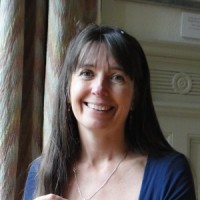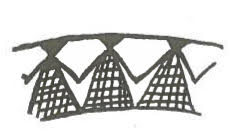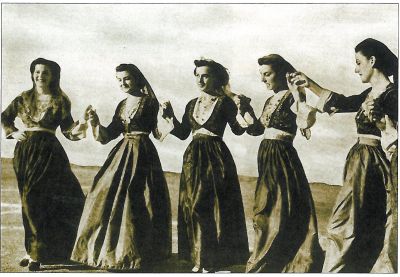
My life’s work with traditional women’s circle dances of Eastern Europe and the Near East has been a natural interweaving of feminism, activism and Goddess spirituality. I would like to share how I came to discover these dances and their potential as tools for healing and transformation.
Circles of women dancing with joined hands appear in rock art, pottery shards, vases and frescoes going back thousands of years1, showing that ritual dance was a primary means of women’s worship. I believe that existing women’s circle dance traditions of the Balkans are direct descendants of these rituals. In their expression of values of partnership, sustainability, and peace, they are living links to the matrifocal Goddess culture of Old Europe as articulated by Marija Gimbutas.2

Tell Halaf, Iraq, ca, 5000-4000 BCE (Garfinkel)
Incorporating symbols of the Goddess in her many guises, these women’s ritual dances are deeply spiritual. They are feminist in the way they provide women with a place of power, not ‘power-over’ but ‘power-from-within.’3 They are an activist practice because the qualities they embody – connection, inclusiveness, balance, empathy, and mutuality – are the principles of a Partnership society, as proposed by Riane Eisler;4 or in Carol Lee Flinders’ term, a society of Belonging.5 Each dance circle is an opportunity to practice being in community in a respectful and cooperative way, which can offer a profound source of healing.6
How did I come to these women’s dances? As a child I was convinced of certain truths: that nature is holy, that God is also female, and that instead of hurting one another, people should celebrate together with music and dance. These longings led me to the rich folk dance traditions of the American melting pot, women’s Middle Eastern Dance circles, and the women’s spirituality network. Around the same time, in the early 1980s, I encountered the meditative communal dance practice known as Sacred Dance. Together with my university training in Intercultural Studies and Dance Movement Therapy, these different streams helped shape the path of my life.
Sacred Dance inspired me very much. Also known as Circle Dance, this community dance form was developed in the 1970s by a German ballet master, Bernhard Wosien, his daughter Maria-Gabriele Wosien and his student Friedel Kloke. Bernhard adapted circular folk dances of Eastern Europe as well as newly choreographed circle dances as tools for personal insight and group connection, and brought Sacred Dance to the ecological community of Findhorn in Scotland in 1976.7 I was able to learn directly from these original teachers as well as Anna Barton and others at Findhorn, where I completed two teacher trainings in the late 1980s.

Kazineh, Iran, ca, 5000 BCE (Garfinkel)
While I found the Sacred Dance choreographies and simplified folk dances very beautiful, I also observed that they were built on a foundation of Christian, masculine, sky-oriented, hero- and saviour-based interpretations of myth and symbol. There remained in my heart a hunger for something more balanced, more inclusive, more earthy, more womanly. I had found this in Middle Eastern dance, a women’s solo dance tradition which goes back thousands of years,8 and wondered whether the women’s circle dances depicted in the archaeological record might also still survive.

Dancing women of Chania, Crete, early 20th C.
Many research trips to the Balkans beginning in the 1980s enabled me to experience living circle dance traditions, and to see how communal dancing was still a normal part of life for many ordinary people. I quickly saw that women and men there typically dance in different styles and with different steps, and also that simple dances were by far the favourites among all ages. By contrast, in the international folk dance groups in western Europe and North America, where I thought I was learning authentic Balkan dances, the repertoire was heavily biased toward men’s dances with large steps, vigorous movements and complicated variations, while women’s dances and simple dances (they are often the same) were ignored almost completely. This was ironic considering that in the many folk dance groups I visited in Western Europe and North America, women dancers overwhelmingly outnumbered the men. This folk dance scene was a microcosm of western society, really, where the male norm is considered the human norm9, and women’s concerns are cast as secondary or denied altogether.
Dances with simple steps were derided as ‘boring’ in these groups, but after I severely injured my knee at the age of twenty (during a men’s dance), these simple dances were the only ones I could do. Now I felt for myself the joyful power of repeating a simple familiar pattern in synchrony with others, where everyone is relaxed and confident in their movements. My studies in dance movement therapy allowed me to understand how simple repeated patterns synchronise brain waves and establish a collective feeling of unity, connectedness and being held10 – the opposite of the atmosphere at folk dance classes where people struggled to execute one complicated choreography after another, in a climate of judgment, hierarchy and competition. Instead of this, the simple dances emphasised acceptance, community and cooperation. This was a life-changing realisation for me. It led me away from the ‘consumer’ culture of a folk dance and circle dance world ever hungry for more new dances, and set me on my path of rediscovering simple women’s circle dances as a practice of healing and a source of wisdom.
Through my immersion in this world, I entered a lineage of transmission, a way of accessing and understanding encoded wisdom which has been faithfully preserved in the dances for many generations. My dance therapy training and my experience of women’s spirituality circles, along with the original Findhorn example of consciously using dances for groupwork, helped me recognise the potential these dances still have – not as ethnographic curios or audience entertainment, but as powerful living tools for healing and transformation. Through these experiences I came to see the dances as a movement practice like yoga or t’ai chi, or a women’s mystery school where the dances transmit encoded information with conscious intent.
An excerpt from Laura Shannon’s essay in the recently released She Rises Vol. 2 from Mago Books.
1 Yosef Garfinkel, Dancing at the Dawn Of Agriculture, p. 3.
2 Marija Gimbutas, The Language of the Goddess, pp. xvii-xxi and 321.
3 Starhawk, Truth or Dare, p. 10.
4 Riane Eisler, The Chalice and the Blade, pp. 7-41.
5 Carol Lee Flinders, Rebalancing the World, pp. 201-202.
6 Laura Shannon, “Women’s Ritual Dances: An Ancient Source of Healing in Our Time”, pp. 138-157.
7 Maria-Gabriele Wosien, Bernhard Wosien: Der Weg Des Tänzers, pp. 21-22
8 Wendy Buonaventura, Serpent of the Nile, pp. 25-26.
9 Dale Spender, Man Made Language, pp. 1-3.
10 Barbara Ehrenreich, Dancing in the Streets, pp. 337-343.
Laura Shannon has been researching and teaching traditional women’s ritual dances since 1987. She is considered one of the ‘grandmothers’ of the worldwide Sacred / Circle Dance movement and gives workshops regularly in over twenty countries worldwide. Laura holds an honours degree in Intercultural Studies (1986) and a diploma in Dance Movement Therapy (1990). She has also dedicated much time to primary research in Balkan and Greek villages, learning songs, dances, rituals and textile patterns which have been passed down for many generations, and which embody an age-old worldview of sustainability, community, and reverence for the earth. Laura’s essay ‘Women’s Ritual Dances: An Ancient Source of Healing in Our Times’, was published in Dancing on the Earth. Laura lives partly in Greece and partly in the Findhorn ecological community in Scotland.
No comments:
Post a Comment